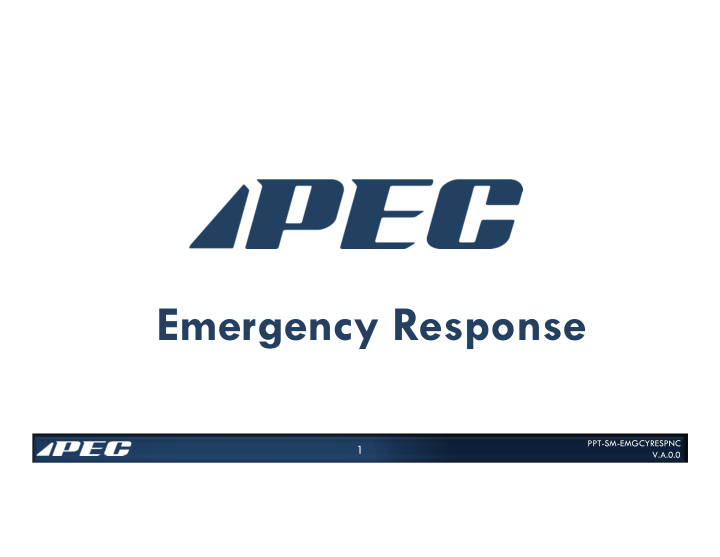



Emergency Response PPT-SM-EMGCYRESPNC 1 V.A.0.0
Potential Emergencies Potential emergencies include • Fires or explosions • Injury • Toxic gas release • Hazardous chemical spills • Structural failure • Motor vehicle accidents • Terrorist threats • Natural disasters PPT-SM-EMGCYRESPNC 2 V.A.0.0
Potential Emergencies • Understand your role in your company’s emergency plan • Develop a mental plan on how to respond to catastrophic incidents • Locate emergency equipment and exits before an emergency occurs PPT-SM-EMGCYRESPNC 3 V.A.0.0
Potential Emergencies In the event of an emergency • Do not assist unless you have the Preparation is proper training a key to good • Do not jeopardize your own safety • Your primary responsibility is self- safety. rescue • Check emergency equipment and know how to use it • Be prepared PPT-SM-EMGCYRESPNC 4 V.A.0.0
Potential Emergencies When you first arrive on a jobsite, locate • Fire alarms and fire extinguishers • Quickest routes to exits and safe havens • Escape respirators and other emergency PPE • Safety showers, eyewash stations and first aid kits • Windsocks PPT-SM-EMGCYRESPNC 5 V.A.0.0
Emergency Action Plans • Required by OSHA • The purpose is to organize actions during jobsite emergencies • A written plan outlines all requirements of your company’s emergency action plan • The written plan must be kept at the jobsite and be available for worker review PPT-SM-EMGCYRESPNC 6 V.A.0.0
Emergency Action Plans • The company must review all parts of the action plan with you Make sure someone • Your company should conduct communicates the facility emergency regular emergency drills so that action plan to you. all workers know what to do and where to proceed during emergency PPT-SM-EMGCYRESPNC 7 V.A.0.0
Emergency Action Plans Workers should be familiar with the following • How to report emergencies • Evacuation routes • Who to ask for information PPT-SM-EMGCYRESPNC 8 V.A.0.0
Site Specific Contingency Plans • Describes how workers will respond to different types of situations • Details of plans vary from facility to facility PPT-SM-EMGCYRESPNC 9 V.A.0.0
Site Specific Contingency Plans Immediate action plan consisting of steps you need to take immediately after an incident Alert and account for workers • Locate and use required PPE • Move from source and proceed to assembly area • Report to supervisor • Initiate evacuation if needed • Implement control measures for situation • Notify officials as required • Monitor for reentry • PPT-SM-EMGCYRESPNC 10 V.A.0.0
Site Specific Contingency Plans Your company should review the emergency action plan with you • When plan is developed • When responsibilities or designated actions under the plan change • Whenever the plan is changed PPT-SM-EMGCYRESPNC 11 V.A.0.0
OSHA Minimum Requirements Include in an emergency action plan • Reporting of fires and other emergencies • Evacuation procedures and emergency escape routes • Critical plant operation procedures • Accounting for all workers after an emergency evacuation • Rescue and medical duties • Emergency contact list PPT-SM-EMGCYRESPNC 12 V.A.0.0
OSHA Minimum Requirements • Know how to report emergencies • Notify a supervisor or the proper authorities • It is imperative that emergency situations be immediately reported PPT-SM-EMGCYRESPNC 13 V.A.0.0
Evacuation Procedures An evacuation policy helps workers understand • Who is authorized to order an evacuation • When an evacuation would be necessary • How to evacuate • What routes to take PPT-SM-EMGCYRESPNC 14 V.A.0.0
Evacuation Procedures • Describe actions such as shutting windows, turning off equipment and closing doors • You must know about the following – Assembly points – Wind direction ◦ Move crosswind, then proceed upwind – Specialized equipment PPT-SM-EMGCYRESPNC 15 V.A.0.0
Evacuation Procedures Shelter-in-place • Find the nearest safe haven and stay there until given an all clear signal PPT-SM-EMGCYRESPNC 16 V.A.0.0
Emergency Escape Routes Emergency exit routes must be • Clearly marked and well lit • Wide enough to accommodate workers • Unobstructed • Unlikely to expose workers to additional hazards PPT-SM-EMGCYRESPNC 17 V.A.0.0
PPT-SM-EMGCYRESPNC 18 V.A.0.0
Accounting for Workers • Emergency action plans must include procedures to account for workers after the evacuation to ensure everyone is safe • This informs emergency responders of any missing workers PPT-SM-EMGCYRESPNC 19 V.A.0.0
Alarm Systems • Preferred method to inform workers that an emergency exists • Purpose of alarm systems is to reduce severity of incidents by providing an early warning signal so workers can escape • Must be seen and heard in affected areas PPT-SM-EMGCYRESPNC 20 V.A.0.0
Audible Alarms • Include bells, horns, sirens and voice announcement systems • Distinguished above and apart from normal sound level PPT-SM-EMGCYRESPNC 21 V.A.0.0
Visual Alarms • Use steady, flashing or strobe lights to alert workers to an emergency situation where noise levels are high • Alert workers with hearing loss or disability • Strobe lights are the most effective means PPT-SM-EMGCYRESPNC 22 V.A.0.0
Alarms Basic precautions for alarms • Be able to distinguish between signals • Be familiar with how to sound alarm • Give attention to visitors • Must be distinctive • Must be perceived above noise and light levels • If unable to recognize alarm, contact supervisor PPT-SM-EMGCYRESPNC 23 V.A.0.0
Training • Should reflect written policies of the company • Workers required to retrain annually PPT-SM-EMGCYRESPNC 24 V.A.0.0
PPT-SM-EMGCYRESPNC 25 V.A.0.0
Recommend
More recommend